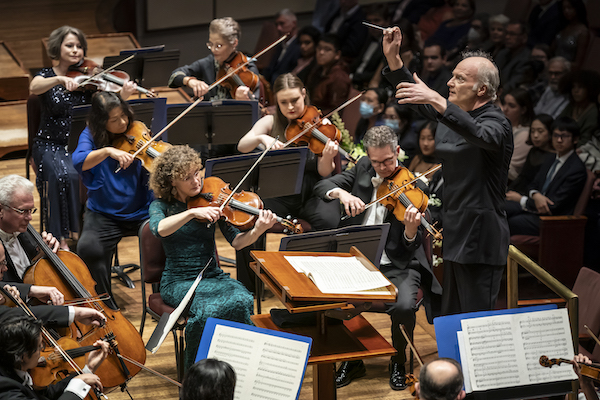NSO and friends fête opening of Noseda’s seventh season in style

Gianandrea Noseda conducted the National Symphony Orchestra’s gala opening concert Saturday night at the Kennedy Center. Photo: Scott Suchman
Gianandrea Noseda returned to Washington this week, for the official opening of his seventh season as music director of the National Symphony Orchestra. The gala concert in the Kennedy Center Concert Hall on Saturday evening, preceded by cocktails and followed by a dinner, took place smoothly in spite of Tropical Storm Ophelia dousing the city with wind-swept rain. Among the speeches came the news that the NSO was one of two American orchestras nominated by Gramophone for “Orchestra of the Year.”
For the tell-tale drum roll that begins the usual performance of the national anthem to open the season, Noseda cued two musicians standing at snare drums on either side of the chorister balcony. The orchestra, attired in tuxedos and brightly colored gowns, played The Star-Spangled Banner with their accustomed gusto.
The reason for the special placement of the snare drums was revealed in the concert opener, the Overture to Rossini’s opera La gazza ladra (The Thieving Magpie). It opens with solo rolls for two drummers, heard first one by one and then a third time together. The spatial arrangement highlighted the antiphonal interplay of these crucial parts, heard at the beginning of major sections and throughout the work.
Noseda led with minimal gestures, enough to keep the ensemble on track and sounding confident in this fizzy score. Violins and flutes danced through their intricate lines crisply, with bright touches from piccolo player Carole Bean. Assistant principal oboist Jamie Roberts rendered the wry leaning solo of the final section with panache, and the Rossini rocket crescendos were cagily marshaled by Noseda’s hands.
The string section got its moment in the sun with a piece much less conventionally suited to a gala program, Elgar’s Introduction and Allegro. Noseda savored the opening section with lavish rubato, moving forward as much as holding back. For the solo parts given to a string quartet, gathered around his podium, Noseda turned to the assistant principal musicians of his string sections: associate concertmaster Ying Fu, second violinist Dayna Hepler, violist Abigail Evans Kreuzer, and cellist Glenn Garlick.

Photo: Scott Suchman
Evans Kreuzer distinguished herself with a mellow, nostalgic tone in the melancholy melody heard first in the Introduction and then again at important moments in the Allegro section. Elgar identified this tune as one he had heard sung some distance away while he was on holiday in Wales. Much of the piece hinges on its comforting return, as after the agitated fugue dispatched with efficient accuracy by the NSO toward the middle of the piece.
The orchestra last played Carlos Simon’s brief Fate Now Conquers in 2021, under Jonathon Heyward, in the role for which it was created, as an introduction to Beethoven’s Seventh Symphony. Tense strings and trumpets chattering like a telegraph signal made nervous ripples through much of the piece, based harmonically and rhythmically on the second movement of the Seventh Symphony, the funeral march.
Simon took his title from one of Beethoven’s notebooks where, around 1815, the composer wrote down a quotation that begins with those words. The lines are drawn from Book 22 of Homer’s Iliad, spoken by Hector as he faces death at the hand of Achilles, resolved to do one last great deed that will be remembered. Out of the orchestral chaos in the music, principal cellist David Hardy arose beautifully on a plaintive solo before the piece finally subsided.
To feature the full orchestra, Noseda closed the concert with Ravel’s marvelous orchestration of Mussorgsky’s Pictures at an Exhibition. He last conducted the piece in 2018, and while there were some similarities in the approach, the reading sounded more fully realized this time. After a gleaming trumpet solo on the “Promenade” melody that returns throughout the piece, the “Gnomus” movement hobbled along in grotesque starts and stops.
Unusual instruments made suave appearances, including the alto saxophone in the “Old Castle” movement and the forthright tenor tuba of acting assistant principal trombonist Casey Jones on the main melody of the “Bydlo” section, with the plodding accompaniment not exaggerated. “Tuileries” teased with coyness rather than bratty childishness, and the “Ballet of the Chicks” remained light in its antic prancing.
Even the “Samuel Goldenberg and Schmuyle” movement downplayed the often overdone garrulousness of the two arguing characters. Likewise the brass chords of the “Catacombs” movement menaced in a way more ghostly than ominous. The NSO sounded like a well-oiled machine in the quick-moving “Baba-Yaga” section, leading up to the carefully managed buildup of dynamic force in “The Great Gate of Kyiv.” The evening’s fine playing and warm ovations are yet another sign of the positive direction the NSO is going in the Noseda era.
Denis Kozhukhin joins Gianandrea Noseda and the NSO for a program dedicated to the music of Rachmaninoff September 28 to 30. kennedy-center.org
